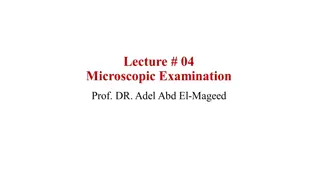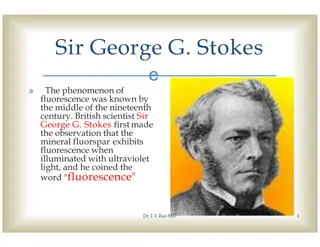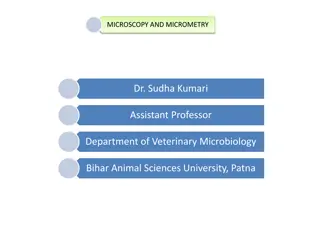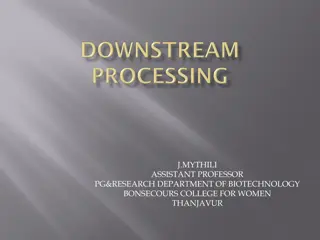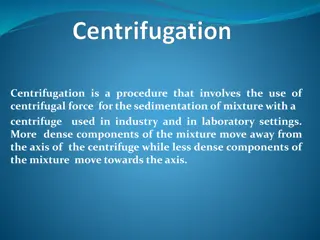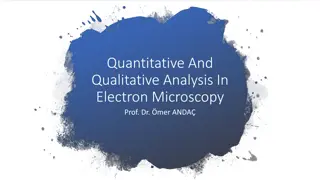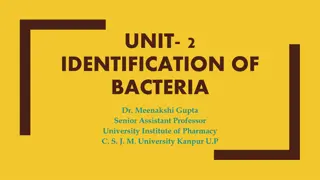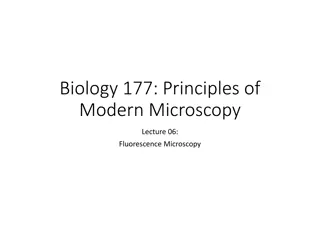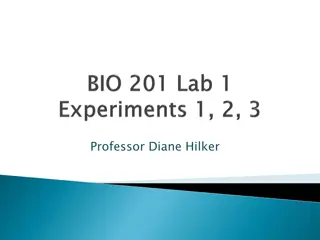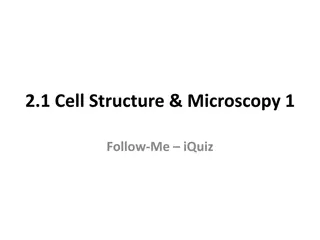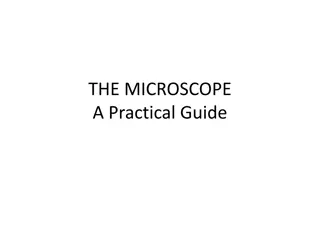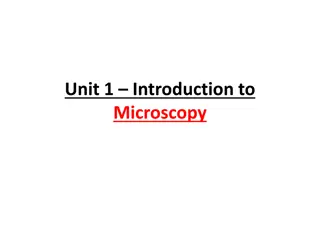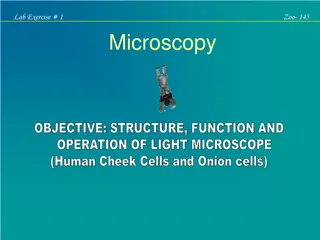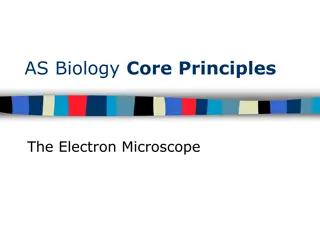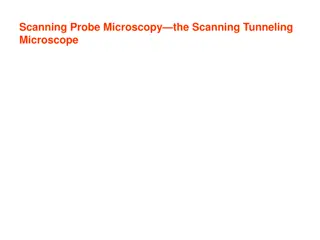Principles and Applications of Centrifugation in Microtomy and Microscopy
Centrifugation is a process that separates substances based on density using high-speed rotation. This article explores the basic principles of centrifugation, instrumentation, and applications in the fields of microtomy and microscopy. It covers the different types of centrifuges, such as low-speed, high-speed, and ultra centrifuges, along with their respective uses and care requirements.
Download Presentation

Please find below an Image/Link to download the presentation.
The content on the website is provided AS IS for your information and personal use only. It may not be sold, licensed, or shared on other websites without obtaining consent from the author. Download presentation by click this link. If you encounter any issues during the download, it is possible that the publisher has removed the file from their server.
E N D
Presentation Transcript
UNIT I:MICROTOMY,MICROSCOPY,CENTRI FUGATION 1.3-PRINCIPALS AND APPLICATIONS OF CENTRIFUGATION
INTRODUCTION DEFINATION BASIC PRINCIPLES OF CENTRIFUGATION INSTRUMENTATION: LOW SPEED CENTRIFUGATION HIGH SPEED CENTRIFUGATION ULTRA CENTRIFUGE APPLICATIONS OF CENTRIFUGATION CARE OF CENTRIFUGES AND ROTORS CONCLUSION REFRENCES
WHAT IS CENTRIFUGE? WHAT IS CENTRIFUGATION?
An apparatus that rotates at high speed and by centrifgal force separates substances of different densities.
A particle,whether it is precipitate,a macromolucle or cell organelle when rotated at high speed is subjected to a centrifugal force. Centrifugal force is defined as F=mw2r Where F=intensity of centrifugal force m=effective mass of sedimenting particle w=angular velocity of rotation r=distance of migrating particles from central axis of rotation
A more common measurement of F,in terms of Gravitational force g,is Relative Centrifugal Force RCF, Is given as RCF=(rpm)2(r) Thus this equation indicates that RCF varies with r,(the distance of the sedimenting particles from axis of rotation Thus it gives idea of only basic principle,it does not take into account other factors ie mass,shape,density of medium. Thus centrifugal force felt by particle is defined as m=m0-movp
It consist of two components,an electric motor to spin the sample and a rotor to hold tubes. Here we describe2 types,the low speed,the high speed. LOW SPEED CENTRIFUGE HIGH SPEED CENTRIFUGE ULTRA CENTRIFUGE
LOW SPEED CENTRIFUGE 1)Most laboratories have a standard low-speed centrifuge used for routine sedimentation of heavy particles 2)The low speed centrifuge has a maximum speed of 4000-5000rpm 3)these instruments usually operate at room temperatures with no means of temperature control. 4)two types of rotors are used in it,Fixed angle and swinging bucket. 5)it is used for sedimentation of red blood cells until the particles are tightly packed into a pellet and supernatant is separated by decantation.
HIGH SPEED CENTRIFUGES HIGH SPEED CENTRIFUGES 1)High speed centrifuges are used in more sophisticated biochemical applications,higher speeds and temperature control of the rotor chamber are essential. 2)The operator of this instrument can carefully control speed and temperature which is required for sensitive biological samples. 3)three types of rotors are available for high speed centrifugation-fixed angle,swinging bucket,vertical rotors
It is the most sofisticated instrument Intense heat is generated due to high speed thus the spining chambers must be refrigirated and kept at high vaccum. It is used for both preparative work and analytical work.
There are two techniques on which the application of centrifuge is based on 1)preparative technique preparative technique VELOCITY SEDIMENTATION CENTRIFUGATION PREPARATIVE DIFFERENTIAL CENTRIFUGATION
All analytical techniques require use of an ultra centrifuge and can be classified as 1)DIFFERENTIAL CENTRIFUGATION 2)DENSITY GRADIENT CENTRIFUGATION A)ZONAL CENTRIFUGATION B)ISOPYCNIC CENTRIFUGATION
1)DIFFERENTIAL CENTRIFUGATION a)Differential centrifugation is a technique commonly used by biochemists. b)tissue such as liver is homogenisfd at 32 degree in a sucrose solution that contains buffer c)the homogenate is then placed in a centrifuge and spun at constant centrifugal force at constant temperature. d)after sometime a sediment forms at the bottom of centrifuge called pellet and overlying solution called supernatant. e)the overlying solution is then placed in another centrifuge tube which is then rotated at higher speeds.
DENSITY GRADIENT CENTRIFUGATION 1)This type of centrifugation is mainly used to purify viruses,ribosomes,membranese etc. b)A sucrose density gradient is created by gently overlaying lower concentrations of sucrose on higher concentrations in centrifuge tubes c)the particles of interest are placed on top of the gradient and centrifuge in ultra centrifuges. d)the particles travel through the gradient until they reach a point at which their density matches with the density of surrounding sucrose.,the the fraction is removed and analyzed.
ZONAL CENTRIFUGATION a)zonal centrifugation is also known as band or gradient centrifugation b)it relies on the concept of sedimentation coefficient (ie movement of sediment through liquid medium) c)in this technique a density gradient is created in a test tube with sucrose and high density at the bottom. d)the sample of protein is placed on the top of the gradient and then centrifuged. e)the proteins sediment according to their sedimentation coefficient and the fractions are collected by creating a hole at the bottom of tube.
ISOPYCNIC CENTRIFUGATION a)It is also called as density gradient centrifugation. b)the solution of biological sample and cesium salt is uniformly distributed in a centrifuge tube and rotated in an ultra centrifuge. c)under the influence of centrifugal force the cesium salts redistributes to form a density gradient from top to bottom. d)the sample molecules move to the region where their density equals to the density of gradient.
1)Carefully read the manual before using centrifuges 2)Select proper operating conditions 3)Check rotor for cleanliness and for damage 4)Select proper rotor of definate size 5)Be suer the rotor is clean and undamaged 6)keep accurate record of centrifuge and rotors 7)carefully clean rotors after centrifugation.
1)THE CENTRIFUGATION IS A MODERN AND EASY TECHNIQUE OF SEPERATION 2)DUE TO CENTRIFUGATION IT IS EASY TO SEPARATE CELLULAR AND SUB CELLUAR COMPONENTS 3)IT IS USED TO STUDY THE EFFECTS OF CENTRIFUGAL FORCES ON CELLS
REFERENCE Modern and experimental biochemistry- RODNEY BOYER Principles and technique in biochemistry-L WALKER& WILSON




